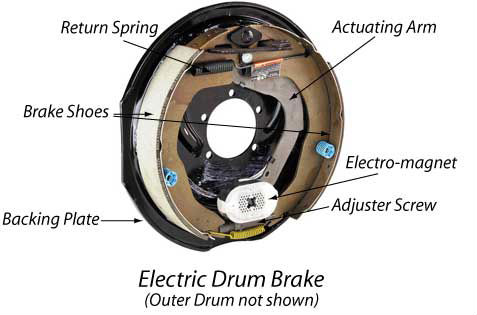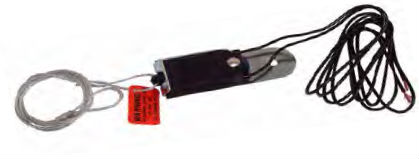Electric Drum Brakes
Electrically operated drum brakes are the most common type of drum brakes on trailers over 5500 lb GTW.
They are activated via a brake controller - either trailer or tow vehicle in cab mounted (see below for more information) - which sends an electrical current (normally 12 volt) proportional to the amount of braking of the tow vehicle, down to an electromagnet within the brake. The electromagnet flings itself axially out to the inner surface of the drum while pulling an actuator arm attached to one of the brake shoes. The second shoe will follow suit almost instantly.

The advantage of electrically operated drum brakes is that because the input from the controller is precise (in cab), the amount of control over the trailer is enhanced whether the trailer is empty or full and gives exceptionally smooth and proportional braking compared to hydraulic surge braking.
Most electric drum brakes have the option of a mechanical park brake lever within the unit.
If you are towing off road or regularly towing over rough roads, specially designed off road electric brake drum units are available. The electro magnets are built with wear resistant plastic inserts to prevent premature failure and the shoe material is designed to cope with dusty environments and the increased heat that this generates more efficiently. Electric drum brakes are unsuitable for boat trailers or prolonged submersion in water.
Again, correct setup and regular maintenance is paramount to ensure reliable and trouble free operation.
Breakaway Brakes

Breakaway brake units are designed to immediately apply full braking power to the trailer brakes should the trailer separate from the tow vehicle.
On electric braked trailers, the breakaway unit is basically a on/off switch box fitted with a removable pin which is attached to a tether cable.
The box is mounted on the trailer tongue and the tether fitted to the tow vehicle with a shackle or hook.
A small rechargeable battery on board the trailer supplies power to the breakaway box and when the pin is pulled from the box (when the trailer comes away from the tow vehicle) full power is instantly applied to the brakes.
Power is supplied to the brakes until the on board battery runs out of juice or the pin is re-fitted to the breakaway box.
It does pay to regularly check the battery charge especially when the trailer is infrequently used. If this is the case, remove the battery and charge it on a mains charger before any trips. Also check that the tow vehicle is charging the battery when plugged into the trailer.
To check if the breakaway unit and battery are working correctly, immobilize the trailer and jack the wheels up. Pull the breakaway pin while a buddy spins the wheels. They should lock up immediately.
The breakaway tether needs to be attached to the tow vehicle and not to the chains, the chains will not pull the breakaway pin out if the trailer decides to part company. Likewise the tether needs to be in good condition and needs to be replaced if kinked, frayed or damaged. If the damaged section fails before the breakaway pin can be pulled, the brakes will not come on.
Breakaway brakes should not be used as a park brake as the battery will quickly lose its charge and the brakes will release.